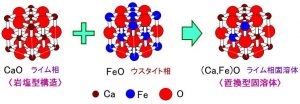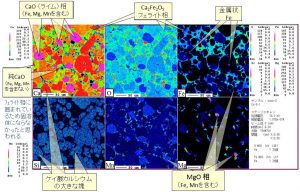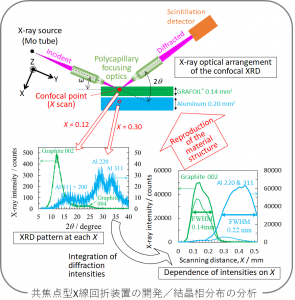Feature of Laboratory
Researches
Based on investigating what elements are composed of substances and how the atoms are arranged, we are conducting research on utilizing substances as new materials or extracting energy from substances. The properties of substances and materials are developed by the combination of various elements. By changing the combination and arrangement of elements, it is possible to create substances with completely different properties and functions. Also, the chemical reaction of a substance involves the entry and exit of energy, so it can be used as an energy source. We believe that if we can find new ways to use substances, we can make the most of our limited resources and contribute to the realization of a sustainable and prosperous life.
Specifically, we are conducting the following research:
(1) Development of chemical reaction process
We are researching new production methods for hydrogen and ammonia, which are important as new energy and chemical raw materials. This method utilizes industrial waste such as scrap iron and environmental pollutants such as carbon dioxide. We are analyzing the reaction mechanism and examining the appropriate reaction conditions to improve the production efficiency of hydrogen and ammonia.
(2) Analysis and reactivity evaluation of wastes
For the purpose of utilizing steel slag, which is industrial waste, we conduct detailed analysis of its components.
We are also working on elucidating the interaction between components, the mechanism by which that interaction appears, and evaluating chemical reactivity.
We are also working on elucidating the interactions between components and the mechanisms by which these interactions appear, and evaluating chemical reactivity.
(3) Development and utilization of new X-ray analysis methods
By utilizing X-ray analysis methods such as X-ray fluorescence and X-ray diffraction, we can analyze the atomic level structure and bonding state of the above substances and materials, and clarify the mechanisms that lead to the properties and functions of the substances. Furthermore, we are developing a new X-ray analysis method unique to our laboratory that can analyze various materials without breaking them and examine the distribution of invisible substances and the defect structure inside the materials.
1. How to produce hydrogen energy? — Observation of chemical reactions and elucidation of mechanisms, determination of efficient reaction conditions
Hydrogen energy is rarely found in nature. Therefore, it must be converted from other energy sources. In our laboratory, we are investigating the use of the energy contained in used iron scrap to produce hydrogen by water splitting. When carbon dioxide is added, hydrogen can be produced at room temperature. In other words, hydrogen can be produced from waste (iron and carbon dioxide). This reaction can also absorb carbon dioxide and immobilize it as carbonate. In addition, ammonia, which supports the human food supply as a raw material for nitrogenous fertilizers and is expected to be used as a hydrogen carrier in recent years, can be synthesized from iron nitrides by a similar reaction.
 Hydrogen made from iron powder and carbon dioxide (carbonated water) is used to power LED.
Hydrogen made from iron powder and carbon dioxide (carbonated water) is used to power LED.
2. analysis and recycling of waste materials — X-ray analysis of steel slag and its recycling
The production of iron (steel), which supports industry and the life of our society, generates a large amount of waste material called steel slag. In order to effectively utilize this waste as a material, it is necessary to understand the components it contains. We analyze the types and amounts of calcium oxide, iron oxide, other oxides, silicates, phosphates, carbonates, and various other components. Our laboratory also synthesizes these components of slag and studies their properties. We analyze the slag by powder X-ray diffraction, electron microscopy, and thermal analysis, as well as by various treatments such as steam exposure, heat treatment, acid washing, and solvent extraction to compare the slag with the actual slag and to improve our understanding of the slag and its composition.

Lime CaO and FeO form solid solution (Ca,Fe)O, which changes reactivity with water.

Elemental distribution of converter slag (EPMA image); Analyzing the substances contained in the slag to utilize it as a resource
3.The material world explored by X-rays – Analysis and evaluation of materials using X-rays, and elucidation of mechanisms of chemical reactions and functionality
Many people think of X-rays in terms of radiography, but X-rays can not only “see through” but can also analyze atoms using absorption and scattering phenomena.Since the wavelength of X-rays is much shorter than that of visible light, we can observe a much smaller world than what we can see with our eyes (visible light), and we can see what elements are contained, how they are arranged to form materials, and how electrons behave. In other words, it helps us understand how materials are formed and what properties they possess.
Our laboratory uses X-rays to evaluate the structure and properties of synthesized materials, materials with interesting properties and functions, and waste materials to be recycled, and to observe how they change when they undergo chemical reactions.In addition, our laboratory is developing new X-ray instruments for more realistic and direct observation of materials and their dynamic behavior.
X-ray fluorescence analysis can analyze elements contained in converter slag as they are.

Confocal X-ray diffractometers can be used to analyze crystalline phases in specific parts of a sample.
Message to students
I want graduates to be active in various fields after they enter the world of work. Therefore, I have set a variety of research themes in order to obtain a broad perspective and knowledge. I hope you will be interested in the research of other members as well as your own research theme, deepen your understanding, and actively participate in discussions. Needless to say, the visible research results are evaluated, but the attitude toward the research, the cooperativeness in living in the laboratory, the attitude to adhere to the rules, and take seriously things are comprehensively evaluated.
Recent Publications
“Effect of shape and composition of steel particles on simultaneous H2 production and CO2 fixation”, ISIJ International, Vol.64 (2024), No.10, pp.1607-1614.
https://doi.org/10.2355/isijinternational.ISIJINT-2024-129.
https://doi.org/10.2355/isijinternational.ISIJINT-2024-129.
“Change of State of Lime Phase and Inhibition of Hydration Reaction by Coexisting Oxides in Steelmaking Slag”,
Hiromi Eba, Kousuke Yonemoto, Yuuki Suzuki,
ISIJ International, Volume 61, Issue 5, 2021, Pages 1594-1602.
https://doi.org/10.2355/isijinternational.ISIJINT-2020-602
“Ammonia production using iron nitride and water as hydrogen source under mild temperature and pressure”,
Hiromi Eba, Yuki Masuzoe, Toru Sugihara, Hayao Yagi, Tian Liu,
International Journal of Hydrogen Energy, Volume 46, Issue 18, 2021, Pages 10642-10652.
https://doi.org/10.1016/j.ijhydene.2020.12.194
“Progress of hydrogen gas generation by reaction between iron and steel powder and carbonate water in the temperature range near room temperature”,
Hiromi Eba, Masashi Takahashi, KenjiSakurai,
International Journal of Hydrogen Energy, Volume 45, Issue 27, 18 May 2020, Pages 13832-13840.
https://doi.org/10.1016/j.ijhydene.2020.03.087
“Observation of crystalline phase distribution with confocal angle-dispersive X-ray diffractometer”, Hiromi Eba, Yoshihito Kitakubo, Satsuki Awaji, Masashi Takahashi, Nuclear Instruments and Methods in Physics Research Section B: Beam Interactions with Materials and Atoms, Volume 456, Pages 42-48, October 2019. Doi:10.1016/j.nimb.2019.07.004
https://www.sciencedirect.com/science/article/pii/S0168583X19304859
“Nondestructive Analysis of Depth Distribution of Materials by Confocal X-ray Diffraction”, Hiromi Eba et al, Chemistry Letters 2018, 47, 1545.
https://www.journal.csj.jp/doi/10.1246/cl.180796
“Versatile chemical handling to confine radioactive cesium as stable inorganic crystal”, Duy Quang Nguyen, Hiromi Eba, Kenji Sakurai, Scientific Reports, Vol. 8, 15051 (2018)
https://www.nature.com/articles/s41598-018-32943-9
“X-Ray Diffraction Analysis of Magnesia-Phase Solid Solution in Steel Slag (in Japanese)”, Journal of the Society of Inorganic Materials, Japan,Vol.25,2018,p.269-275.

